Xiaolong Zheng
MathSticks: A Benchmark for Visual Symbolic Compositional Reasoning with Matchstick Puzzles
Oct 01, 2025Abstract:We introduce \textsc{MathSticks}, a benchmark for Visual Symbolic Compositional Reasoning (VSCR), which unifies visual perception, symbolic manipulation, and arithmetic consistency. Each task presents an incorrect matchstick equation that must be corrected by moving one or two sticks under strict conservation rules. The benchmark includes both text-guided and purely visual settings, systematically covering digit scale, move complexity, solution multiplicity, and operator variation, with 1.4M generated instances and a curated test set. Evaluations of 14 vision--language models reveal substantial limitations: closed-source models succeed only on simple cases, open-source models fail in the visual regime, while humans exceed 90\% accuracy. These findings establish \textsc{MathSticks} as a rigorous testbed for advancing compositional reasoning across vision and symbols. Our code and dataset are publicly available at https://github.com/Yuheng2000/MathSticks.
When Deepfakes Look Real: Detecting AI-Generated Faces with Unlabeled Data due to Annotation Challenges
Aug 12, 2025Abstract:Existing deepfake detection methods heavily depend on labeled training data. However, as AI-generated content becomes increasingly realistic, even \textbf{human annotators struggle to distinguish} between deepfakes and authentic images. This makes the labeling process both time-consuming and less reliable. Specifically, there is a growing demand for approaches that can effectively utilize large-scale unlabeled data from online social networks. Unlike typical unsupervised learning tasks, where categories are distinct, AI-generated faces closely mimic real image distributions and share strong similarities, causing performance drop in conventional strategies. In this paper, we introduce the Dual-Path Guidance Network (DPGNet), to tackle two key challenges: (1) bridging the domain gap between faces from different generation models, and (2) utilizing unlabeled image samples. The method features two core modules: text-guided cross-domain alignment, which uses learnable prompts to unify visual and textual embeddings into a domain-invariant feature space, and curriculum-driven pseudo label generation, which dynamically exploit more informative unlabeled samples. To prevent catastrophic forgetting, we also facilitate bridging between domains via cross-domain knowledge distillation. Extensive experiments on \textbf{11 popular datasets}, show that DPGNet outperforms SoTA approaches by \textbf{6.3\%}, highlighting its effectiveness in leveraging unlabeled data to address the annotation challenges posed by the increasing realism of deepfakes.
VisualTrans: A Benchmark for Real-World Visual Transformation Reasoning
Aug 06, 2025Abstract:Visual transformation reasoning (VTR) is a vital cognitive capability that empowers intelligent agents to understand dynamic scenes, model causal relationships, and predict future states, and thereby guiding actions and laying the foundation for advanced intelligent systems. However, existing benchmarks suffer from a sim-to-real gap, limited task complexity, and incomplete reasoning coverage, limiting their practical use in real-world scenarios. To address these limitations, we introduce VisualTrans, the first comprehensive benchmark specifically designed for VTR in real-world human-object interaction scenarios. VisualTrans encompasses 12 semantically diverse manipulation tasks and systematically evaluates three essential reasoning dimensions - spatial, procedural, and quantitative - through 6 well-defined subtask types. The benchmark features 472 high-quality question-answer pairs in various formats, including multiple-choice, open-ended counting, and target enumeration. We introduce a scalable data construction pipeline built upon first-person manipulation videos, which integrates task selection, image pair extraction, automated metadata annotation with large multimodal models, and structured question generation. Human verification ensures the final benchmark is both high-quality and interpretable. Evaluations of various state-of-the-art vision-language models show strong performance in static spatial tasks. However, they reveal notable shortcomings in dynamic, multi-step reasoning scenarios, particularly in areas like intermediate state recognition and transformation sequence planning. These findings highlight fundamental weaknesses in temporal modeling and causal reasoning, providing clear directions for future research aimed at developing more capable and generalizable VTR systems. The dataset and code are available at https://github.com/WangYipu2002/VisualTrans.
CRC-SGAD: Conformal Risk Control for Supervised Graph Anomaly Detection
Apr 03, 2025



Abstract:Graph Anomaly Detection (GAD) is critical in security-sensitive domains, yet faces reliability challenges: miscalibrated confidence estimation (underconfidence in normal nodes, overconfidence in anomalies), adversarial vulnerability of derived confidence score under structural perturbations, and limited efficacy of conventional calibration methods for sparse anomaly patterns. Thus we propose CRC-SGAD, a framework integrating statistical risk control into GAD via two innovations: (1) A Dual-Threshold Conformal Risk Control mechanism that provides theoretically guaranteed bounds for both False Negative Rate (FNR) and False Positive Rate (FPR) through providing prediction sets; (2) A Subgraph-aware Spectral Graph Neural Calibrator (SSGNC) that optimizes node representations through adaptive spectral filtering while reducing the size of prediction sets via hybrid loss optimization. Experiments on four datasets and five GAD models demonstrate statistically significant improvements in FNR and FPR control and prediction set size. CRC-SGAD establishes a paradigm for statistically rigorous anomaly detection in graph-structured security applications.
Alleviating Performance Disparity in Adversarial Spatiotemporal Graph Learning Under Zero-Inflated Distribution
Apr 01, 2025Abstract:Spatiotemporal Graph Learning (SGL) under Zero-Inflated Distribution (ZID) is crucial for urban risk management tasks, including crime prediction and traffic accident profiling. However, SGL models are vulnerable to adversarial attacks, compromising their practical utility. While adversarial training (AT) has been widely used to bolster model robustness, our study finds that traditional AT exacerbates performance disparities between majority and minority classes under ZID, potentially leading to irreparable losses due to underreporting critical risk events. In this paper, we first demonstrate the smaller top-k gradients and lower separability of minority class are key factors contributing to this disparity. To address these issues, we propose MinGRE, a framework for Minority Class Gradients and Representations Enhancement. MinGRE employs a multi-dimensional attention mechanism to reweight spatiotemporal gradients, minimizing the gradient distribution discrepancies across classes. Additionally, we introduce an uncertainty-guided contrastive loss to improve the inter-class separability and intra-class compactness of minority representations with higher uncertainty. Extensive experiments demonstrate that the MinGRE framework not only significantly reduces the performance disparity across classes but also achieves enhanced robustness compared to existing baselines. These findings underscore the potential of our method in fostering the development of more equitable and robust models.
RoboBrain: A Unified Brain Model for Robotic Manipulation from Abstract to Concrete
Feb 28, 2025Abstract:Recent advancements in Multimodal Large Language Models (MLLMs) have shown remarkable capabilities across various multimodal contexts. However, their application in robotic scenarios, particularly for long-horizon manipulation tasks, reveals significant limitations. These limitations arise from the current MLLMs lacking three essential robotic brain capabilities: Planning Capability, which involves decomposing complex manipulation instructions into manageable sub-tasks; Affordance Perception, the ability to recognize and interpret the affordances of interactive objects; and Trajectory Prediction, the foresight to anticipate the complete manipulation trajectory necessary for successful execution. To enhance the robotic brain's core capabilities from abstract to concrete, we introduce ShareRobot, a high-quality heterogeneous dataset that labels multi-dimensional information such as task planning, object affordance, and end-effector trajectory. ShareRobot's diversity and accuracy have been meticulously refined by three human annotators. Building on this dataset, we developed RoboBrain, an MLLM-based model that combines robotic and general multi-modal data, utilizes a multi-stage training strategy, and incorporates long videos and high-resolution images to improve its robotic manipulation capabilities. Extensive experiments demonstrate that RoboBrain achieves state-of-the-art performance across various robotic tasks, highlighting its potential to advance robotic brain capabilities.
AdvLoRA: Adversarial Low-Rank Adaptation of Vision-Language Models
Apr 20, 2024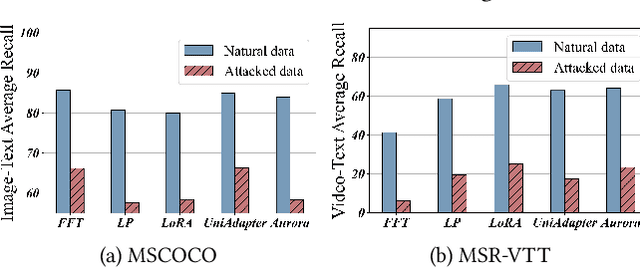



Abstract:Vision-Language Models (VLMs) are a significant technique for Artificial General Intelligence (AGI). With the fast growth of AGI, the security problem become one of the most important challenges for VLMs. In this paper, through extensive experiments, we demonstrate the vulnerability of the conventional adaptation methods for VLMs, which may bring significant security risks. In addition, as the size of the VLMs increases, performing conventional adversarial adaptation techniques on VLMs results in high computational costs. To solve these problems, we propose a parameter-efficient \underline{Adv}ersarial adaptation method named \underline{AdvLoRA} by \underline{Lo}w-\underline{R}ank \underline{A}daptation. At first, we investigate and reveal the intrinsic low-rank property during the adversarial adaptation for VLMs. Different from LoRA, we improve the efficiency and robustness of adversarial adaptation by designing a novel reparameterizing method based on parameter clustering and parameter alignment. In addition, an adaptive parameter update strategy is proposed to further improve the robustness. By these settings, our proposed AdvLoRA alleviates the model security and high resource waste problems. Extensive experiments demonstrate the effectiveness and efficiency of the AdvLoRA.
Adaptive Neural Network Backstepping Control Method for Aerial Manipulator Based on Variable Inertia Parameter Modeling
Dec 08, 2022



Abstract:For the aerial manipulator that performs aerial work tasks, the actual operating environment it faces is very complex, and it is affected by internal and external multi-source disturbances. In this paper, to effectively improve the anti-disturbance control performance of the aerial manipulator, an adaptive neural network backstepping control method based on variable inertia parameter modeling is proposed. Firstly, for the intense internal coupling disturbance, we analyze and model it from the perspective of the generation mechanism of the coupling disturbance, and derive the dynamics model of the aerial manipulator system and the coupling disturbance model based on the variable inertia parameters. Through the proposed coupling disturbance model, we can compensate the strong coupling disturbance in a way of feedforward. Then, the adaptive neural network is proposed and applid to estimate and compensate the additional disturbances, and the closed-loop controller is designed based on the backstepping control method. Finally, we verify the correctness of the proposed coupling disturbance model through physical experiment under a large range motion of the manipulator. Two sets of comparative simulation results also prove the accurate estimation of the proposed adaptive neural network for additional disturbances and the effectiveness and superiority of the proposed control method.
Deep Causal Learning: Representation, Discovery and Inference
Nov 07, 2022



Abstract:Causal learning has attracted much attention in recent years because causality reveals the essential relationship between things and indicates how the world progresses. However, there are many problems and bottlenecks in traditional causal learning methods, such as high-dimensional unstructured variables, combinatorial optimization problems, unknown intervention, unobserved confounders, selection bias and estimation bias. Deep causal learning, that is, causal learning based on deep neural networks, brings new insights for addressing these problems. While many deep learning-based causal discovery and causal inference methods have been proposed, there is a lack of reviews exploring the internal mechanism of deep learning to improve causal learning. In this article, we comprehensively review how deep learning can contribute to causal learning by addressing conventional challenges from three aspects: representation, discovery, and inference. We point out that deep causal learning is important for the theoretical extension and application expansion of causal science and is also an indispensable part of general artificial intelligence. We conclude the article with a summary of open issues and potential directions for future work.
AdaComm: Tracing Channel Dynamics for Reliable Cross-Technology Communication
Sep 30, 2022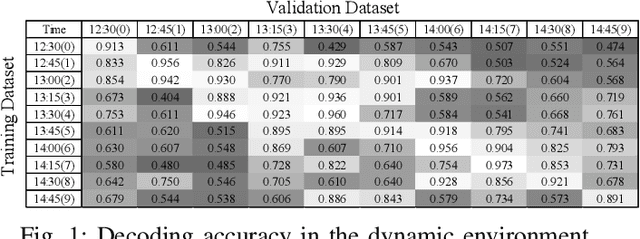
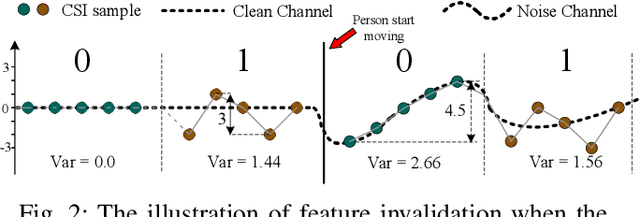
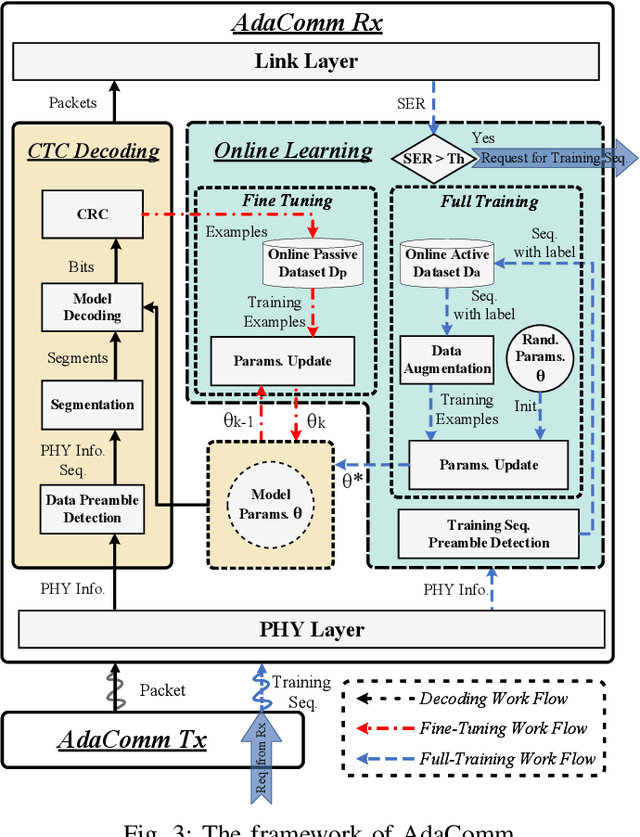
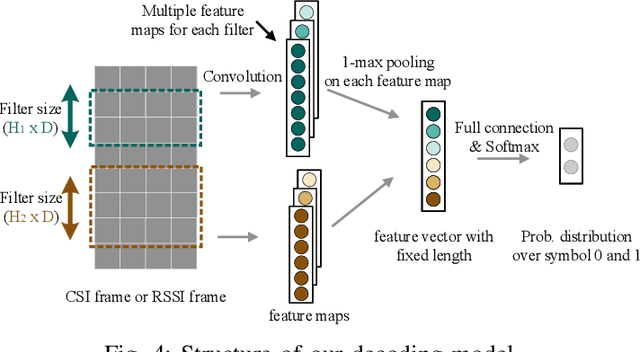
Abstract:Cross-Technology Communication (CTC) is an emerging technology to support direct communication between wireless devices that follow different standards. In spite of the many different proposals from the community to enable CTC, the performance aspect of CTC is an equally important problem but has seldom been studied before. We find this problem is extremely challenging, due to the following reasons: on one hand, a link for CTC is essentially different from a conventional wireless link. The conventional link indicators like RSSI (received signal strength indicator) and SNR (signal to noise ratio) cannot be used to directly characterize a CTC link. On the other hand, the indirect indicators like PER (packet error rate), which is adopted by many existing CTC proposals, cannot capture the short-term link behavior. As a result, the existing CTC proposals fail to keep reliable performance under dynamic channel conditions. In order to address the above challenge, we in this paper propose AdaComm, a generic framework to achieve self-adaptive CTC in dynamic channels. Instead of reactively adjusting the CTC sender, AdaComm adopts online learning mechanism to adaptively adjust the decoding model at the CTC receiver. The self-adaptive decoding model automatically learns the effective features directly from the raw received signals that are embedded with the current channel state. With the lossless channel information, AdaComm further adopts the fine tuning and full training modes to cope with the continuous and abrupt channel dynamics. We implement AdaComm and integrate it with two existing CTC approaches that respectively employ CSI (channel state information) and RSSI as the information carrier. The evaluation results demonstrate that AdaComm can significantly reduce the SER (symbol error rate) by 72.9% and 49.2%, respectively, compared with the existing approaches.
 Add to Chrome
Add to Chrome Add to Firefox
Add to Firefox Add to Edge
Add to Edge